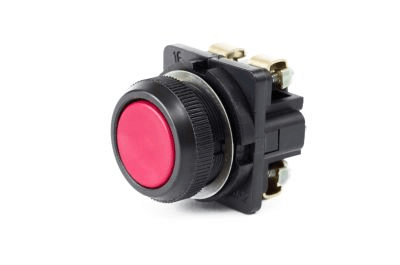What Is a Switch Button?

A switch button is a type of switch, usually called a push-button switch, in which the switch contacts are turned on and off by human operation.
There are two types of switch buttons: automatic return type and holding type. The former is a type of switch that turns ON (or OFF) only while the button is pushed in and simultaneously turns OFF (or ON) the moment the finger is released. The latter is a type of switch that turns ON (or OFF) when the button is pressed and remains ON (or OFF) even if the finger is removed from the button.
Uses of Switch Buttons
Whether to use an auto-return type or a holding type switch depends on the intended use.
When using an auto-return type switch, it is necessary to have a receiver that can detect the state of the switch instantaneously and connect it to the control of the device. For example, if there is a system controller that can receive instructions from the switch and instantly control the inside of the equipment, an auto-return type switch is used because it can monitor the switch status. On the other hand, if a holding type switch is used, the receiver does not need to take any action as described above. As the switch does not switch between ON and OFF states on its own, the receiver can always control the equipment according to the state of the switch.
Principle of Switch Buttons
Switch buttons are available in three types: a-contact, b-contact, and c-contact.
The a-contact is a contact that turns the switch OFF when the finger is removed from the button and ON when the button is pressed. The a-contact is also called a NO (normally open) contact, meaning that the switch is open during normal operation.
The b-contact is the opposite of the a-contact. B-contact is also called NC (Normal Close) contact, which means “normally closed.”
A c-contact consists of a combination of a and b contacts. As an example, consider three contacts: a, b, and COM. When the button is not pressed, the a-contact and the COM contact are electrically connected. When the button is pressed, the a-contact and the COM contact are non-conductive, and the COM contact and the b-contact conduct instead. The c-contact is a contact that switches the current flowing into the COM terminal between the a-contact and b-contact.
Types of Switch Buttons
Switches are classified according to their applications, such as detection switches used to detect the position of objects, operation switches used for human operation input, and setting switches used to switch functions. The following types of switches can be classified by their structural characteristics, and are used in various places, such as industrial equipment, facilities, and consumer equipment.
Switch buttons are switches that provide human operation input. The actuator moves in the direction of its axis to open or close the contact point. Some actuators are equipped with LEDs, etc., and have both illumination and display functions. There are various types of actuators in terms of shape, size, color, and terminal shape.
There are generally two types of shapes: round body type and square body type. The difference between the two is the shape of the mounting panel. The display part can be rectangular, square, or round. There are also various variations in the illumination and color of the display.
Structure of Switch Buttons
The typical structure of a switch button consists of an actuator, mounting section, switch section, and case section.
The actuator of the switch button is responsible for transmitting the operated movement from the outside to the switch section. With the illuminated type, the surface of the actuator emits light. There are two types of mechanical operation of the actuator: momentary operation and alternate operation. Momentary operation is also called self-return type and turns on only when the switch is pressed in. Alternate operation, also called self-maintaining, is the type that remains on when the switch is pressed. Pressing the switch again releases the depressed state and turns it off.
The mounting part is where the switch body is secured to a panel such as sheet metal. The round body type is fixed with screws using a mounting nut, while the square body type is generally fixed with a snap-in method by simply inserting the switch into a hole.
The switch section opens and closes the electric circuit. The force applied by the actuator is transmitted inside the switch to move the metal moving part to open and close the contacts.
The case part protects the internal switch mechanism and has soldering terminals and other parts protruding from the bottom.